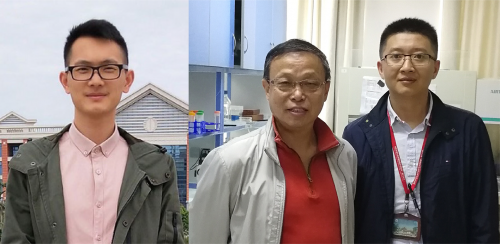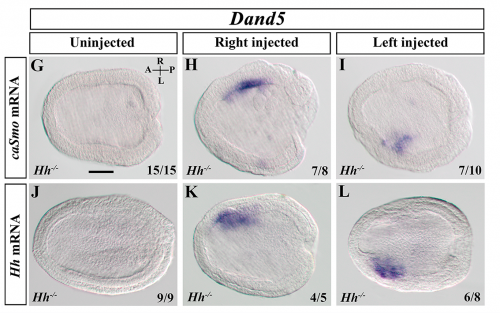The people behind the papers – Xin Zhu, Yiquan Wang and Guang Li
Posted by the Node Interviews, on 26 August 2020
This interview, the 77th in our series, was published in Development earlier this year.
During development, the establishment of directional left-right (L-R) asymmetry is crucial for the correct positioning of organs within the body. How symmetry is broken in the embryo is still incompletely understood at the molecular level, as is its evolutionary history. A new paper in Development tackles this problem with an analysis of L-R asymmetry in the basal chordate amphioxus. We caught up with first author Xin Zhu and supervisors Yiquan Wang and Guang Li of Xiamen University in Fujian, China, to find out more about the work.

Yiquan and Guang, can you give us your scientific biography and the questions your lab is trying to answer?
YW I did my undergraduate study at Anhui Normal University, China, between 1978 and 1982, and then postgraduate training at Shanxi Normal University between 1984 and 1985. I was a teaching assistant at Anhui Normal University in 1983 and became a lecturer there in 1986. My major job during this period was teaching, but I also joined several research programs including developing methods to preserve and breed Chinese alligators in captivity. I then moved on to do my Ph.D. at Nanjing Normal University between 1992 and 1995, followed by postdoctoral training at China Pharmaceutical University in 1997. I went to Hong Kong University of Science & Technology as a visiting scholar in 1998. During this time, I learned many molecular skills, with which I studied the phylogenetic relationship of several groups of animals and developed DNA markers to distinguish Chinese herbs. I became a Professor at Nanjing Normal University in 1999, a visiting professor at Texas University (Houston), USA, in 2000, and a visiting scientist at the University of Cincinnati, USA, in 2001. Several different topics were studied during these years, varying from geography and phylogenetic relationships of reptiles, isolation of genes encoding snake venom, and human population genetics. In 2002, I came back to China, settled down at Xiamen University, and began my work with amphioxus. I retired in January 2018 and Guang inherited my laboratory.
GL Both my Master’s (2003-2006) and Ph.D. (2006-2010) training were supervised by Yiquan, although I also spent nearly one and a half years (2008-2010) in Peter Holland’s laboratory at the University of Oxford as a visiting student. My major interest in this period was gene family evolution among chordates and their potential relationships to certain morphological and physiological features. In 2010, I became an Assistant Professor at Xiamen University and carried on my study on amphioxus in Yiquan’s laboratory. However, I turned my research focus to evolutionary and development biology. To do this, we first established methods for acquiring amphioxus gametes and embryos all year round in 2013, and then methods for generating amphioxus mutant and transgenic lines in 2014 and 2018, respectively. With these methods, we are now able to do in-depth gene function studies in amphioxus. In 2017, I was promoted to be an Associate Professor at Xiamen University and took all responsibilities for the ‘amphioxus lab’ initially set up by Yiquan.
Xin, how did you come to work with Yiquan and Guang and what drives your research today?
I worked on muscle development in fish during my Master’s training. I enjoyed it very much and gained a lot of knowledge and skills in this field. Because of this, I decided to continue my research on developmental biology for my Ph.D. At that time, Yiquan and Guang’s team was working on amphioxus embryonic development with their newly developed methods. Their research topic attracted me very much. In addition, Xiamen University is one of the best and most beautiful universities in China. For these reasons, I sent my CV and expressed my interest to join the team, and luckily, Yiquan and Guang approved my application – I guess they were probably taken by my interests and background in developmental biology. Before I joined the team in 2015, the lab had almost finished their analysis on Cer, Nodal, Lefty and Pitx functions in amphioxus asymmetry development, and had also acquired some evidence indicating that cilia and Hedgehog (Hh) signalling probably act upstream of these genes. I was fascinated by how cilia and Hh signalling regulate amphioxus asymmetry and therefore took this for my Ph.D. study.
What makes amphioxus a good model for studying the development and evolution of L-R asymmetries?
XZ, YW, GL There are several reasons. First, amphioxus occupies a key phylogenetic position among chordates. Second, amphioxus has orthologues (but fewer family members) of most, if not all, genes involved in vertebrate L-R development. It did not undergo extensive genome duplications like vertebrates, and thus retained many features of ancestral chordates. This makes studying the functions of these genes with genetic tools in amphioxus much easier than in vertebrates. Third, in terms of structures, amphioxus embryos are much simpler than those of vertebrates. For example, at the early neurula stage when L-R asymmetry begins to be established, amphioxus embryos are composed of only two layers of cells. Fourth, most morphological features of L-R asymmetry are formed within 24 h after fertilization, and are easy to detect under a stereoscope. Lastly, we have developed a series of methods in recent years which enable us to conduct in-depth functional analysis of genes in amphioxus embryos.

Can you give us the key results of the paper in a paragraph?
XZ, YW, GL We think the key results show that Hh signalling is asymmetrical in amphioxus embryos, and this asymmetric signal is required for and acts upstream of asymmetric Dand5 expression. In addition, we also provide evidence suggesting that asymmetric Hh signalling is achieved through a cilia movement-dependent asymmetric distribution of extracellular Hh protein.
Do Hh signalling and motile cilia play a conserved role in asymmetry in other animals?
XZ, YW, GL Motile cilia appear to play a conserved role in all major lineages of deuterostomes, although their function in asymmetry formation in other bilaterians has not been reported. However, Hh signalling in asymmetry has been demonstrated only in mice, chickens, amphioxus and sea urchins, up to date. Notably, the signalling regulates asymmetry in these animals through different L-R genes: Dand5 in amphioxus and Nodal in mice, chicks and sea urchins. It is currently unclear whether the signalling regulates Dand5 expression in mice (or other vertebrates) as in amphioxus, but it is clear that the signalling is not essential for Nodal expression in amphioxus. Interestingly, most Hh signalling genes are expressed in the site at which asymmetry first occurs in sea urchin and vertebrate embryos. This suggests that the Hh signalling might have an earlier role in the asymmetry development of these animals – future studies are needed to clarify this hypothesis.
The effect of nodal flow on L-R patterning is currently explained by two competing models (two-cilia versus morphogen) – which model does your data best support?
XZ, YW, GL If we must choose one, we would go for the morphogen model, because our data indicate that Hh protein (a kind of morphogen) is asymmetrically distributed in a cilia movement-dependent manner as the morphogen model suggests. However, if the target sensed by the second cilia in the two-cilia model is a morphogen, our results also fit the two-cilia model, as we showed that Hh signalling transduction also requires cilia in amphioxus embryos.
When doing the research, did you have any particular result or eureka moment that has stuck with you?
XZ I got really excited when I found that the Hh fusion protein was asymmetrically distributed in Hh-myc mRNA-injected embryos. This not only told us why Hh signalling is asymmetrically activated in amphioxus embryos, but also explained why caSmo mRNA injection could induce more right isomerism phenotype than Hh mRNA injection.
I got really excited when I found that the Hh fusion protein was asymmetrically distributed
And what about the flipside: any moments of frustration or despair?
XZ There were many moments of frustration during my research on the project. One of them concerns cilia. We have been trying to obtain an amphioxus mutant with cilia defects for many years. For this, we tried to knockdown Kif3a or knockout Kif3a and Foxj1 genes. However, none of these treatments could stop ciliogenesis in the early stages of amphioxus embryos. I was really sad when I saw these negative results.
So what next for you after this paper?
XZ I graduated and left Xiamen in July, and am now working at Changsha University in China. Fish muscle regeneration could be my research area for the next few years.
Where will this work take your lab?
YW, GL Several interesting questions were raised from this work. Why is Hh protein able to be transferred by cilia movement? Is Hh protein enveloped before being transported? Why do Ptch mutants show no L-R defects? Is there a nodal flow in amphioxus embryos and where is it? We have already begun to conduct experiments to address these questions, and hope we can get more exciting results in the near future.
Finally, let’s move outside the lab – what do you like to do in your spare time?
YW I like to meet friends to have some tea or play cards with them.
GL I like to stay at home with family, or have a walk with friends or family within the campus or along the beach.
XZ I like to do some sports in my spare time, such as tennis, golf or swimming. Sometimes I also like going for walks along the beach with my friends and thinking about my research project.


 (No Ratings Yet)
(No Ratings Yet)